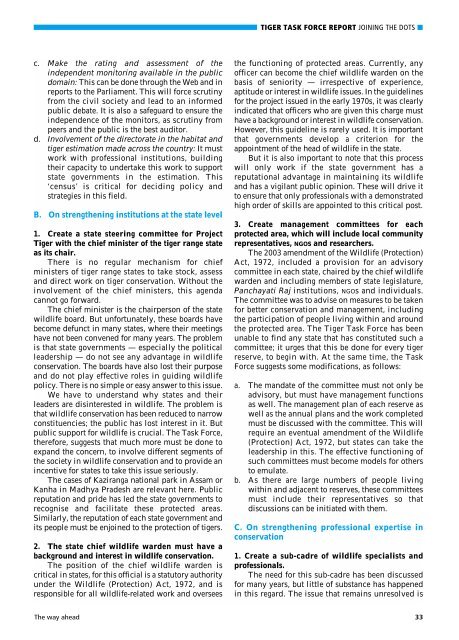Report of the Tiger Task Force - PRS
Report of the Tiger Task Force - PRS
Report of the Tiger Task Force - PRS
Create successful ePaper yourself
Turn your PDF publications into a flip-book with our unique Google optimized e-Paper software.
TIGER TASK FORCE REPORT JOINING THE DOTS ■c. Make <strong>the</strong> rating and assessment <strong>of</strong> <strong>the</strong>independent monitoring available in <strong>the</strong> publicdomain: This can be done through <strong>the</strong> Web and inreports to <strong>the</strong> Parliament. This will force scrutinyfrom <strong>the</strong> civil society and lead to an informedpublic debate. It is also a safeguard to ensure <strong>the</strong>independence <strong>of</strong> <strong>the</strong> monitors, as scrutiny frompeers and <strong>the</strong> public is <strong>the</strong> best auditor.d. Involvement <strong>of</strong> <strong>the</strong> directorate in <strong>the</strong> habitat andtiger estimation made across <strong>the</strong> country: It mustwork with pr<strong>of</strong>essional institutions, building<strong>the</strong>ir capacity to undertake this work to supportstate governments in <strong>the</strong> estimation. This‘census’ is critical for deciding policy andstrategies in this field.B. On streng<strong>the</strong>ning institutions at <strong>the</strong> state level1. Create a state steering committee for Project<strong>Tiger</strong> with <strong>the</strong> chief minister <strong>of</strong> <strong>the</strong> tiger range stateas its chair.There is no regular mechanism for chiefministers <strong>of</strong> tiger range states to take stock, assessand direct work on tiger conservation. Without <strong>the</strong>involvement <strong>of</strong> <strong>the</strong> chief ministers, this agendacannot go forward.The chief minister is <strong>the</strong> chairperson <strong>of</strong> <strong>the</strong> statewildlife board. But unfortunately, <strong>the</strong>se boards havebecome defunct in many states, where <strong>the</strong>ir meetingshave not been convened for many years. The problemis that state governments — especially <strong>the</strong> politicalleadership — do not see any advantage in wildlifeconservation. The boards have also lost <strong>the</strong>ir purposeand do not play effective roles in guiding wildlifepolicy. There is no simple or easy answer to this issue.We have to understand why states and <strong>the</strong>irleaders are disinterested in wildlife. The problem isthat wildlife conservation has been reduced to narrowconstituencies; <strong>the</strong> public has lost interest in it. Butpublic support for wildlife is crucial. The <strong>Task</strong> <strong>Force</strong>,<strong>the</strong>refore, suggests that much more must be done toexpand <strong>the</strong> concern, to involve different segments <strong>of</strong><strong>the</strong> society in wildlife conservation and to provide anincentive for states to take this issue seriously.The cases <strong>of</strong> Kaziranga national park in Assam orKanha in Madhya Pradesh are relevant here. Publicreputation and pride has led <strong>the</strong> state governments torecognise and facilitate <strong>the</strong>se protected areas.Similarly, <strong>the</strong> reputation <strong>of</strong> each state government andits people must be enjoined to <strong>the</strong> protection <strong>of</strong> tigers.2. The state chief wildlife warden must have abackground and interest in wildlife conservation.The position <strong>of</strong> <strong>the</strong> chief wildlife warden iscritical in states, for this <strong>of</strong>ficial is a statutory authorityunder <strong>the</strong> Wildlife (Protection) Act, 1972, and isresponsible for all wildlife-related work and oversees<strong>the</strong> functioning <strong>of</strong> protected areas. Currently, any<strong>of</strong>ficer can become <strong>the</strong> chief wildlife warden on <strong>the</strong>basis <strong>of</strong> seniority — irrespective <strong>of</strong> experience,aptitude or interest in wildlife issues. In <strong>the</strong> guidelinesfor <strong>the</strong> project issued in <strong>the</strong> early 1970s, it was clearlyindicated that <strong>of</strong>ficers who are given this charge musthave a background or interest in wildlife conservation.However, this guideline is rarely used. It is importantthat governments develop a criterion for <strong>the</strong>appointment <strong>of</strong> <strong>the</strong> head <strong>of</strong> wildlife in <strong>the</strong> state.But it is also important to note that this processwill only work if <strong>the</strong> state government has areputational advantage in maintaining its wildlifeand has a vigilant public opinion. These will drive itto ensure that only pr<strong>of</strong>essionals with a demonstratedhigh order <strong>of</strong> skills are appointed to this critical post.3. Create management committees for eachprotected area, which will include local communityrepresentatives, NGOs and researchers.The 2003 amendment <strong>of</strong> <strong>the</strong> Wildlife (Protection)Act, 1972, included a provision for an advisorycommittee in each state, chaired by <strong>the</strong> chief wildlifewarden and including members <strong>of</strong> state legislature,Panchayati Raj institutions, NGOs and individuals.The committee was to advise on measures to be takenfor better conservation and management, including<strong>the</strong> participation <strong>of</strong> people living within and around<strong>the</strong> protected area. The <strong>Tiger</strong> <strong>Task</strong> <strong>Force</strong> has beenunable to find any state that has constituted such acommittee; it urges that this be done for every tigerreserve, to begin with. At <strong>the</strong> same time, <strong>the</strong> <strong>Task</strong><strong>Force</strong> suggests some modifications, as follows:a. The mandate <strong>of</strong> <strong>the</strong> committee must not only beadvisory, but must have management functionsas well. The management plan <strong>of</strong> each reserve aswell as <strong>the</strong> annual plans and <strong>the</strong> work completedmust be discussed with <strong>the</strong> committee. This willrequire an eventual amendment <strong>of</strong> <strong>the</strong> Wildlife(Protection) Act, 1972, but states can take <strong>the</strong>leadership in this. The effective functioning <strong>of</strong>such committees must become models for o<strong>the</strong>rsto emulate.b. As <strong>the</strong>re are large numbers <strong>of</strong> people livingwithin and adjacent to reserves, <strong>the</strong>se committeesmust include <strong>the</strong>ir representatives so thatdiscussions can be initiated with <strong>the</strong>m.C. On streng<strong>the</strong>ning pr<strong>of</strong>essional expertise inconservation1. Create a sub-cadre <strong>of</strong> wildlife specialists andpr<strong>of</strong>essionals.The need for this sub-cadre has been discussedfor many years, but little <strong>of</strong> substance has happenedin this regard. The issue that remains unresolved isThe way ahead 33
















